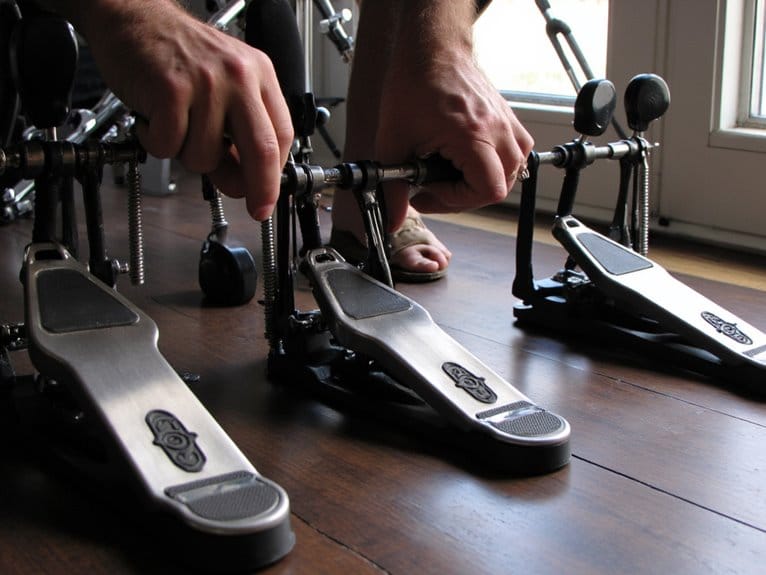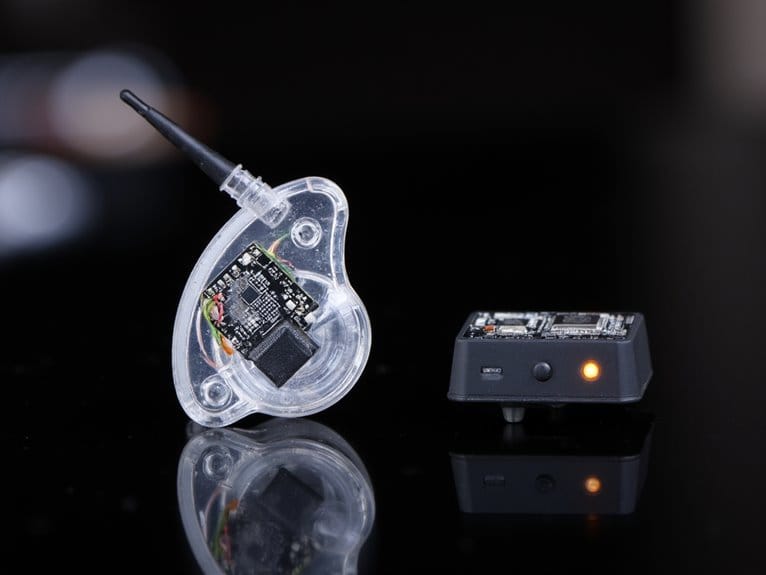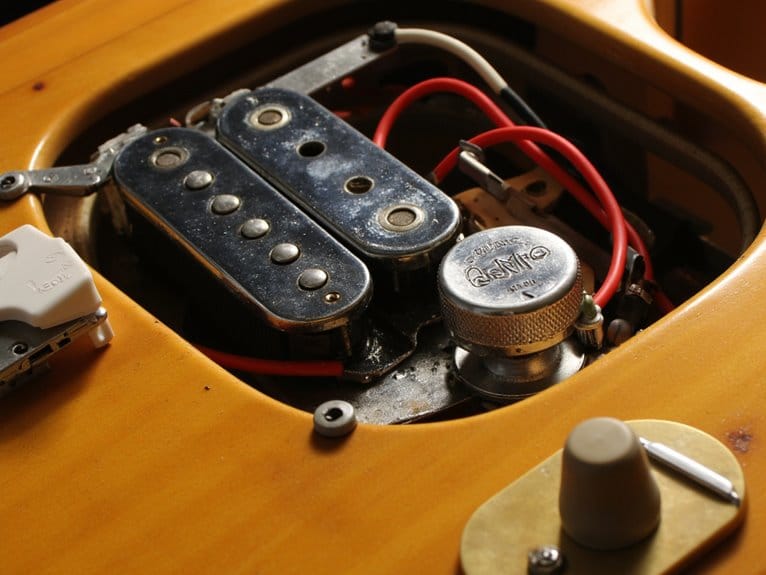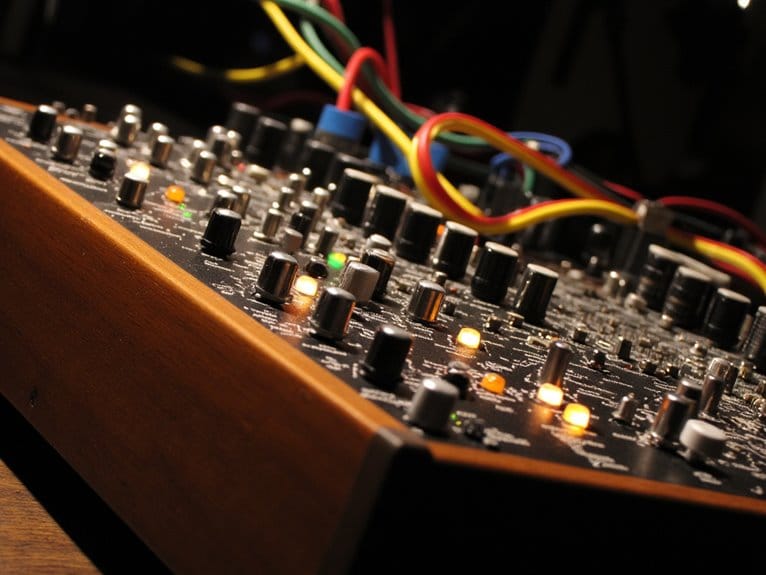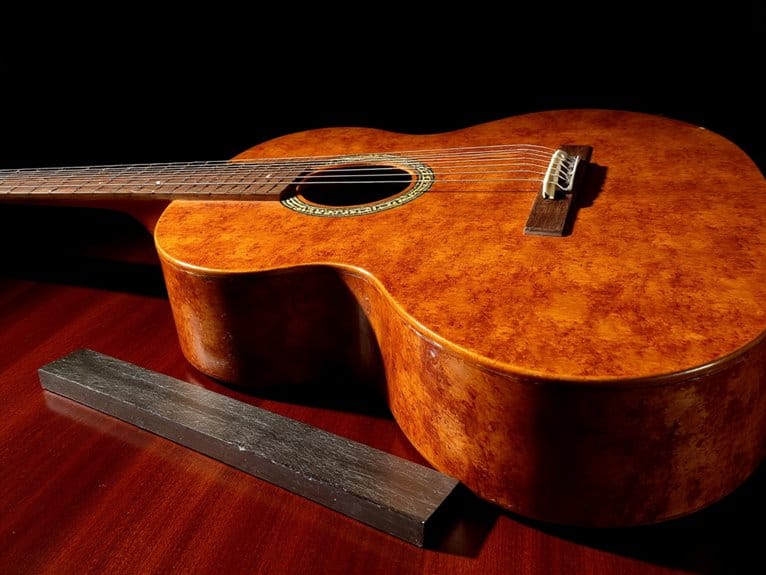Selecting the Right Bass Drum Pedal
When selecting your bass drum pedal, you’ll need to contemplate three key factors: drive mechanism, your skill level, and budget. Direct drive offers immediate response but costs more, while chain drive provides balanced power for most players, and belt drive delivers smooth, quiet operation perfect for studio work. Beginners should start with single-chain pedals under $100, while intermediate drummers benefit from double-chain or belt systems in the $150-200 range, and advanced players often prefer direct-drive models for maximum precision. Testing different spring tensions, cam designs, and beater types helps you find the right feel for your playing style, and exploring these components further reveals how each element influences your drumming performance.
We are supported by our audience. When you purchase through links on our site, we may earn an affiliate commission, at no extra cost for you. Learn more.
Notable Insights
- Choose drive mechanism based on needs: direct drive for power, chain drive for balance, belt drive for quiet operation.
- Match pedal type to skill level: single-chain for beginners, double-chain for intermediate, direct-drive for advanced players.
- Consider essential features like spring tension, cam design, beater type, and footboard comfort for optimal performance.
- Plan budget accordingly: entry-level under $100, intermediate $150-200, premium features around $200-240 for professional quality.
- Test pedals hands-on to find the right feel and response for your playing style and musical genre.
Understanding Bass Drum Pedal Drive Mechanisms
When you’re diving into the world of bass drum pedals, the drive mechanism serves as the heart of the entire system, determining how your foot’s energy translates into beater motion and ultimately affects your drumming performance.
Understanding mechanism variations becomes vital for making an informed purchase, as each type offers distinct characteristics that’ll match different playing styles and requirements.
Each drive mechanism offers unique characteristics that directly impact your playing style and performance requirements.
A thorough drive comparison reveals three primary options: direct drive delivers immediate, powerful response through solid metal connections, eliminating flex for precise control.
Chain drive pedals use bicycle-style chains connecting footboard to cam, providing balanced power with natural feel and adjustable spring tension. Some models feature dual chains to prevent flex and ensure consistent performance during demanding playing sessions.
Belt drive mechanisms employ woven nylon or leather belts, offering smooth, quiet operation with reduced friction, making them ideal for studio work where noise matters. Direct drive systems feature fewer moving parts compared to chain alternatives, making them highly durable and requiring minimal maintenance over extended use.
Essential Features That Impact Performance
While drive mechanisms form the foundation of your pedal’s operation, the individual features and components determine whether you’ll struggle through performances or achieve the precise control and comfort that elevates your drumming.
Spring tension controls your pedal’s rebound speed, with tighter settings requiring more effort but enabling faster strokes, while adjustable mechanisms let you fine-tune responsiveness during play.
Cam design markedly impacts feel-round cams provide consistent control, while offset designs build progressive tension for aggressive playing styles.
Your beater type shapes tone quality, with felt producing warm sounds, wood delivering punchy attacks, and plastic offering bright articulation.
Footboard comfort affects leverage and foot placement, while stability mechanisms prevent unwanted movement. Many drummers find that custom options provide the specific configurations needed for their unique playing requirements and setup preferences.
Finally, pedal weight influences portability without compromising the solid construction needed for reliable performance. Premium brands feature superior engineering and materials that ensure longevity under demanding performance conditions.
For drummers seeking to blend acoustic and electronic elements, dual-zone capabilities in trigger-compatible pedals enable independent triggering of beater strikes and rim contacts.
Matching Pedal Types to Your Playing Style and Skill Level
Your musical journey and technical abilities should drive your pedal selection more than flashy marketing claims or peer recommendations, since the wrong choice can actually hinder your development and leave you fighting your equipment instead of expressing your creativity.
Understanding how pedal feel translates to different skill levels helps narrow your options considerably.
Matching pedal sensitivity and response characteristics to your current technical abilities prevents equipment from becoming a barrier to musical progress.
Consider these progression pathways that match drummer preferences to practical needs:
- Beginners benefit from affordable single-chain pedals that develop fundamental control without overwhelming sensitivity.
- Intermediate players often upgrade to double-chain or belt-drive systems for improved responsiveness during dynamic playing.
- Advanced drummers gravitate toward direct-drive or high-end double-chain pedals offering maximum precision for technical genres.
Your genre requirements matter equally-rock and metal demand stability, while jazz emphasizes finesse and lighter action. Testing pedals is crucial since finding the right feel and response requires hands-on experience rather than relying solely on specifications. Professional drummers like Dave Grohl and Travis Barker demonstrate how the right pedal choice supports their distinctive playing styles and contributes to their signature sounds. Quality pedals typically feature essential components like adjustable spring tension, beater angle customization, and reliable chain drive systems that enhance performance across different musical styles.
Budget Planning and Model Recommendations
Most drummers discover that their pedal budget directly correlates with their commitment level and playing frequency, making it essential to establish realistic financial boundaries before you’re tempted by that $400 direct-drive masterpiece that’ll drain your gear fund for months.
Entry level options under $100, like the Pearl P930 Demonator or DW 2000 Series, provide solid functionality for beginners without breaking the bank.
Moving into the $150-200 range opens doors to intermediate choices like the DW 3000 Series, which offers dual-chain drive and enhanced precision. Premium features become accessible around $200-240 with pedals like the Yamaha FP9500C, delivering professional-grade responsiveness. Consider the importance of solid base plates when evaluating pedals in this price range, as stability becomes crucial for secure performance during intense playing sessions.
For drummers who view their equipment as a lifetime investment, the Trick Pro 1-V stands out as the ultimate choice despite its higher price point, offering unmatched responsiveness and reliability that justifies the cost over years of performance.
On a final note
You’ve now got the knowledge to make an informed decision about your bass drum pedal purchase. Remember, there’s no universally “perfect” pedal-what matters is finding one that complements your technique, fits your budget, and enhances your playing experience. Don’t overthink it too much; even seasoned drummers sometimes discover their preferences change over time. Start with a solid mid-range option if you’re unsure, and you’ll likely be quite satisfied.

